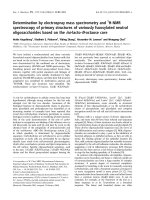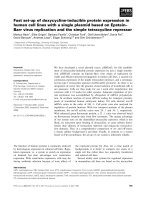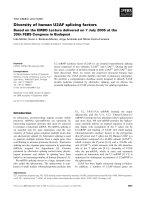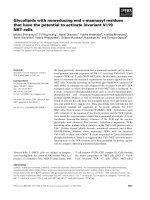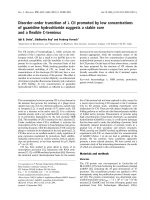Human capital accumulation by low skilled workers with borrowing constraints a welfare analysis based on the lucas rural urban migration model
Bạn đang xem bản rút gọn của tài liệu. Xem và tải ngay bản đầy đủ của tài liệu tại đây (1.17 MB, 128 trang )
HUMAN CAPITAL ACCUMULATION BY
LOW-SKILLED WORKERS WITH
BORROWING CONSTRAINTS – A WELFARE
ANALYSIS BASED ON THE LUCAS
RURAL-URBAN MIGRATION MODEL
XU YIQIN
(M.S. PEKING UNIVERSITY)
A THESIS SUBMITTED
FOR THE DEGREE OF DOCTOR OF PHILOSOPHY
DEPARTMENT OF REAL ESTATE
SCHOOL OF DESIGN AND ENVIRONMENT
NATIONAL UNIVERSITY OF SINGAPORE
AUGUST, 2012
Declaration
I hereby declare that this thesis is my original work and it has been written by
me in its entirety.
I have duly acknowledged all the sources of information which have been used in
the thesis.
This thesis has also not been submitted for any degree in any university previously.
Xu Yiqin
21 August 2012
ii
iii
Acknowledgement
Acknowledgements I would like to express my gratitude to all those who helped
me during the writing of this thesis. I gratefully acknowledge the help of my
supervisor, Prof. Fu Yuming, who has offered me valuable suggestions in the
academic studies. In the preparation of the thesis he has spent much time helping
me to write thesis and provided me with inspiring advice. Without his patient
instruction, insightful criticism and expert guidance, the completion of this thesis
would not have been possible. My heartfelt thanks also go to Prof. Liao Wen-Chi
who gave me considerable help by means of suggestion, comments and criticism.
I am also pleased to acknowledge my classmates for their invaluable assistance
throughout the preparation of the original manuscript. They graciously made
considerable comments and sound suggestions to the outline of this paper.
I should finally like to express my gratitude to my beloved parents who have always
been helping me out of difficulties and supporting without a word of complaint.
iv
v
Abstract
Human capital accumulation by individual workers and urbanization are two cen-
tral factors underlying sustained economic growth (Lucas, ”On the Mechanics of
Economic Development,” Journal of Monetary Economics, 1988, 22, 3-42 [72];
Jones and Romer, ”The New Kaldor Facts: Ideas, Institutions, Population, and
Human Capital,” American Economic Journal: Macro-economics, 2010, 2(1), 224-
245 [14]). The persistent incentive for human capital accumulation depends cru-
cially on spillover effects derived from close proximity to human capital in an
urban context (Lucas, ”Life earnings and rural-urban migration,” Journal of Po-
litical Economy, 2004, 112(1), S29-S59 [73]; Lucas, ”Trade and the Diffusion of
the Industrial Revolution,” American Economic Journal: Macroeconomics, 2009,
1(1), 1-25 [74]). This dissertation builds on the work of Lucas (2004) to study
the incentive for rural (low-skilled) workers to migrate to the urban sector and to
invest in human capital accumulation. Our focus is on the role of financing con-
straints, which in reality discourage human capital accumulation by low-skilled
workers but are omitted in Lucas (2004).
Workers must allocate time to learning in order to accumulate human capital,
forgoing employment income. Absent borrowing constraints, low-skilled workers
can smooth their consumption by borrowing from future employment income,
which is expected to grow with human capital. When the financing constraint
is binding, the low-skilled workers must lower current consumption to finance
learning and thus face a reduced incentive for human capital accumulation due to
vi
the greater opportunity cost of learning. We solve the dynamic mo del in Lucas
(2004) subject to a borrowing constraint. We show that the lifetime utility of
low-skilled workers is reduced when they are unable to borrow from future income
to smooth consumption during the period of unemployment devoted to human
capital accumulation.
We use the model to study several stylized facts and rural-urban migration policy
issues for an economy in transition from a low-skilled economy to a high-skilled
economy. First, we show that, when low-skilled workers are unable to borrow
from future income, the saving rate of rural household will rise in response to the
opening of the urban sector to rural migrants and the attendant opportunities for
profitable human capital accumulation. This increased saving rate is necessary for
financing the initial period of unemployment in cities in order for new migrants
to catch up in human capital accumulation. In contrast, absent the borrowing
constraint, the rural saving rate will be negative in response to the opening of
the urban sector, as low-skilled workers attempt to smooth consumption in an-
ticipation of higher future income. Second, we show that a rise in rural-urban
migration cost in the presence of a binding borrowing constraint for low-skilled
workers reduces their incentive to migrate to cities to accumulate human capital.
Consequently, rural-urban migration, human capital accumulation and economic
growth all slow down and rural-urban income disparity widens. Third, we show
that the urban government can help to mitigate the borrowing constraint faced
by low-skilled workers by subsidizing their migration to cities and financing the
subsidy with increased future income-tax revenue produced by an expanded high-
skilled urban workforce. Such a subsidy program is self-financing and will raise not
only the lifetime welfare of the low-skilled migrants but also the rate of rural-urban
migration, human capital accumulation, and economic growth. We use numerical
analysis to quantify the impact of the borrowing constraint, rural-urban migration
cost, and the self-financing migration subsidy programs.
vii
Finally, we apply the results of the model to shed lights on China’s recent expe-
rience of urbanization and economic development. We observe a significant rise
in rural household saving rate (above the urban household saving rate) in the late
1990s when the urban housing and labor markets are liberalized to allow rural
workers the freedom to live and work in cities. This phenomenon, not well ex-
plained by the previous studies, is consistent with the predictions of our model. In
addition, we document evidence from extant literature regarding the lagging ur-
banization, lagging human capital accumulation, and widening rural-urban income
gaps in China in relation to income growth. These features are consistent with
a rural-urban migration (and human capital accumulation) process constrained
by a lack of financing and high opportunity costs of human capital accumulation
for low-skilled migrants. We discuss the causes for the high opportunity cost of
human capital accumulation for low-skilled migrants. Furthermore, we use the
insights from our model to argue that the welfare implications of many rural-urban
migration policy issues currently debated in China can be better understood from
the point of view of mitigating the financing constraint for human capital accumu-
lation by low-skilled migrant families. For instance, the urban low-income housing
benefits should be extended to rural migrant families to encourage their human
capital accumulation in cities for the benefit of the whole economy.
viii
ix
Contents
Declaration ii
Acknowledgement iv
Abstract vi
1 Introduction 1
1.1 Motivation of this research . . . . . . . . . . . . . . . . . . . . . . . 1
1.2 Stylized facts . . . . . . . . . . . . . . . . . . . . . . . . . . . . . . 4
1.3 Statement of this research . . . . . . . . . . . . . . . . . . . . . . . 9
1.4 Structure of this thesis . . . . . . . . . . . . . . . . . . . . . . . . . 12
2 China’s urbanization experience 14
2.1 Urbanization history in China . . . . . . . . . . . . . . . . . . . . . 14
2.2 Characteristics of rural-urban migration . . . . . . . . . . . . . . . 16
2.2.1 Regulated rural-urban migration . . . . . . . . . . . . . . . 17
x
2.2.2 Lagging urbanization . . . . . . . . . . . . . . . . . . . . . . 20
2.2.3 Slow human capital accumulation . . . . . . . . . . . . . . . 23
2.2.4 Increasing income disparity and high saving rate . . . . . . . 25
2.2.5 Summary . . . . . . . . . . . . . . . . . . . . . . . . . . . . 30
3 Literature Review 32
3.1 Urbanization and Knowledge Spillover . . . . . . . . . . . . . . . . 33
3.2 Rural-Urban Migration Models . . . . . . . . . . . . . . . . . . . . 37
4 Core Models 44
4.1 Foundation of models . . . . . . . . . . . . . . . . . . . . . . . . . . 45
4.1.1 Two sectors . . . . . . . . . . . . . . . . . . . . . . . . . . . 45
4.1.2 Effect of knowledge spillover in the city . . . . . . . . . . . . 51
4.2 Transition with borrowing constraint . . . . . . . . . . . . . . . . . 55
4.2.1 Rural-urban migration barriers . . . . . . . . . . . . . . . . 55
4.2.2 Borrowing constraints and migration time . . . . . . . . . . 56
4.2.3 Equilibrium state with borrowing constraint . . . . . . . . . 62
4.3 Policy influence and social welfare . . . . . . . . . . . . . . . . . . . 63
4.3.1 Migration tax . . . . . . . . . . . . . . . . . . . . . . . . . . 63
4.3.2 Self-finance via government subsidy . . . . . . . . . . . . . . 64
xi
5 Numerical Study 67
5.1 Methodology . . . . . . . . . . . . . . . . . . . . . . . . . . . . . . 67
5.2 Effect of borrowing constraint . . . . . . . . . . . . . . . . . . . . . 70
5.3 Effect of government policies . . . . . . . . . . . . . . . . . . . . . 74
5.4 Consumption and saving patterns . . . . . . . . . . . . . . . . . . . 78
5.5 Social welfare . . . . . . . . . . . . . . . . . . . . . . . . . . . . . . 83
5.6 Summary . . . . . . . . . . . . . . . . . . . . . . . . . . . . . . . . 85
6 Policy Implications 87
6.1 New rural-urban migration regulation . . . . . . . . . . . . . . . . . 87
6.2 Affordable housing . . . . . . . . . . . . . . . . . . . . . . . . . . . 89
6.3 Student loans system . . . . . . . . . . . . . . . . . . . . . . . . . . 91
6.4 Summary . . . . . . . . . . . . . . . . . . . . . . . . . . . . . . . . 93
7 Conclusion 95
7.1 Significance and Contribution . . . . . . . . . . . . . . . . . . . . . 95
7.2 Further Research Directions . . . . . . . . . . . . . . . . . . . . . . 97
References 98
Appendix 109
xii
List of Tables
1.1 Annual income growth and urban population growth . . . . . . . . 5
2.1 Composition of rural-urban migrants . . . . . . . . . . . . . . . . . 18
2.2 Chenery - Syrquin’s patterns of economic structure and develop-
ment . . . . . . . . . . . . . . . . . . . . . . . . . . . . . . . . . . 22
2.3 Education level of urban, rural and migration residents . . . . . . . 23
5.1 The value of parameters . . . . . . . . . . . . . . . . . . . . . . . . 68
5.2 Migration time and individual lifetime utility response to ξ . . . . . 75
5.3 Aggregate lifetime utility and migration time with different θ . . . . 83
5.4 Aggregate lifetime utility and migration time with different ξ . . . . 84
5.5 Aggregate lifetime utility and migration time with different τ . . . . 85
6.1 National student loans expenditure proportion in 2009 . . . . . . . 92
1
LIST OF TABLES 2
List of Figures
1.1 Flow process of rural-urban migration . . . . . . . . . . . . . . . . 4
1.2 Urbanization level and GNI per capita in 2010 . . . . . . . . . . . . 5
1.3 Relationship of urbanization level and education level of labor force 6
1.4 Flow process of rural-urban migration . . . . . . . . . . . . . . . . . 10
2.1 % of population residing in urban areas in China from 1949-2010 . . 15
2.2 % of industrial and non-agricultural value-added in GDP, and ur-
banization rate in China . . . . . . . . . . . . . . . . . . . . . . . . 20
2.3 The number of graduates from and entering students into tertiary
education in China . . . . . . . . . . . . . . . . . . . . . . . . . . . 24
2.4 Gross domestic saving in China (% of GDP) . . . . . . . . . . . . . 25
2.5 Rural and urban saving rates 1990-2008 . . . . . . . . . . . . . . . . 26
2.6 Rural and urban income disparities 1990-2008 . . . . . . . . . . . . 27
4.1 Lifetime utility value with different start migration time . . . . . . 60
5.1 Lifetime utility value with and without borrowing constraint . . . . 70
3
LIST OF FIGURES 4
5.2 Labor force allocation curve with and without borrowing constraint 71
5.3 Lifetime utility value with different external effect of human capital 73
5.4 Labor force relocation with different external effect of human capital 73
5.5 Lifetime utility value with different value of ξ (θ = 0.8) . . . . . . . 75
5.6 Labor force relocation with different value of ξ (θ = 0.8) . . . . . . 76
5.7 Lifetime utility value with different income tax . . . . . . . . . . . . 77
5.8 Lifetime utility value with different income tax . . . . . . . . . . . . 78
5.9 Initial consumption level with different migration time . . . . . . . 79
5.10 Consumption patterns with different cases . . . . . . . . . . . . . . 80
5.11 Saving patterns with different cases . . . . . . . . . . . . . . . . . . 81
5.12 Individual income ratio between urban and rural workers with and
without borrowing constraint . . . . . . . . . . . . . . . . . . . . . 82
Chapter 1
Introduction
1.1 Motivation of this research
In China, today’s younger rural generation aspires for decent jobs in the service
sector or even to white-collar jobs, unlike their parents who had migrated from
rural to urban areas only aimed to be out of poverty. Reported by Rahul Jacob
in Financial Times in 2012
1
, Mr Zeng, a 23-year-old rural boy in China, said he
tried to find a formal job that only required eight hours a day in cities because he
thought his unskilled and routine factory work was useless and meaningless and
he had learnt nothing by doing it for a long time. Unfortunately, he not even had
a formal job in the city because he had quit school where he was young. Although
he realized the importance of education and skill, it is hard for him to accumulate
human capital in the city due to less energy and lack of financial support. Mr
Zeng is the typical representative of new rural generations. Therefore, whether
to migration is a dilemma for rural households. They migrate to cities for the
high quality of life and a nice working environment, but in reality, they cannot
get a high added-value job in cities because they are usually low-skilled workers
1
/>1
CHAPTER 1. INTRODUCTION 2
and also lack of money and preferential policies to support their human capital
accumulation.
The objective of this thesis is to build a model and framework to analyze the hu-
man capital accumulation of low-skilled workers during the rural-urban migration
process and to provide solutions that can accelerate the rural-urban migration and
speed up skill transformation.
Rural-urban migration is not only a physical movement of people from rural areas
to urban areas
2
, but more importantly, it is the transformation of a low-skilled
worker to a high-skilled worker. Rural-urban migration is a natural process and a
result of the difference between traditional agricultural technology and modern
industrial technology. In general, urban population growth in most countries
is more rapid than total population growth because migrants from rural areas
contribute almost half of its growth.
The high urbanization level is accompanying the high average education level and
industrialization development. The country with higher average education and in-
dustrialization level often has more population residing in urban areas. However,
some developing countries do not follow this regular pattern, especially China.
The urbanization in China is slower than its industrialization; in addition, av-
erage schooling level is still below the world’s average level. Furthermore, gross
domestic saving ratio and rural saving rate in China are so prominent in the
lagging urbanization process.
Migration is a dilemma for rural households with a borrowing constraint, as above
Mr Zeng’ story described. On the one hand, the human capital spillover plays
a key role in rural-urban migration and skill transformation (Lucas, 2004 [73]),
which attracts rural people out of rural area into urban areas by borrowing money
from future to invest in their human capital accumulation in cities. The rural
2
Rural-Urban migration has the same meaning with Urbanization, defined by the United
Nations as movement of people from rural to urban areas with population growth.
CHAPTER 1. INTRODUCTION 3
migrant can get superior income after successfully become a high-skilled worker by
accumulating human capital for the advantage of the knowledge spillover in cities.
On the other hand, borrowing constraint is a major obstacle for rural households’
human capital accumulation in cities. Borrowing constraint decelerates the human
capital accumulation of low-skilled rural workers and delays rural-urban migration
as well, because it can alter consumption and saving behavior of rural migrants
and decrease the incentive for human capital investment.
Rural migrants must consider a tradeoff between human capital spillover in cities
and borrowing constraints. Absent borrowing constraints, low-skilled workers can
smooth their consumption by borrowing from future employment income, which
expects to grow with their human capital. When the borrowing constraint is
binding, the low-skilled workers, if he want to get high income by invest on his
human capital, must lower current consumption to finance their learning, conse-
quently they will face a reduced incentive for human capital accumulation due to
the greater opportunity cost of learning.
Therefore, we are attempting to solve the dynamic Lucas model [74] subject to
a borrowing constraint to answer those questions. How to finance human capi-
tal accumulation? When to migrate to a city? What about the change of social
welfare with borrowing constraint? Furthermore, this extended model with bor-
rowing constraint can be shed lights on the experience of rural-urban migration
and economic development. In addition, this model can analyze the impacts of
institutional policies on rural-urban migration and human capital accumulation of
low-skilled rural workers.
CHAPTER 1. INTRODUCTION 4
1.2 Stylized facts
Some stylized facts of global urbanization process have offered in this section.
Generally, rural-urban migration is asso ciated with economic development and
growth. Most of the developed countries have finished the urbanization process
by the advancing of the Industrial Revolution. In the United States, about 5% of
the population lived in cities in 1800, but about 50% of the population lived in
cities by 1920. Throughout the 19th century, the US was urbanizing. The same
was true for most European societies during the 19th century, such as UK, France
etc. In 2010 about 80% of the US population lives in cities or suburbs, it seems
the urbanization in US is close to an end stage.
Figure 1.1: Flow process of rural-urban migration
Source: table StatisticalTables.pdf
However, some less-developed countries and most developing countries are still
undergoing urbanization process in the report of World Bank the percentage of
population residing in urban areas is only 45.55 in 2010, comparing to the 77.57 of
more-developed countries. In practice, urbanization from rural land to urban areas
is mainly economic activities for those less developed and developing countries, in
Asia, Africa and some part of South America (Fig 1.1).
Since 60’s of the twentieth century, numbers of developing countries have been
CHAPTER 1. INTRODUCTION 5
accelerating their rural-urban migration due to progress of industrialization, open-
ness of international trade, technology progress, augment of living level inequality
and social welfare between the rural and urban area. This spatial transformation
tightly links with the transition of economic structure, knowledge transfer and
institutional policies.
0
10
20
30
40
50
60
70
80
90
100
2 2.5 3 3.5 4 4.5 5
% of Urban Population
Log value of GNI
Figure 1.2: Urbanization level and GNI per capita in 2010
Source: The World Bank
Table 1.1: Annual income growth and urban population growth
Countries Brazil Columbia S. Korea Indonesia China
Annual urban population 1950-70 1951-73 1960-70 1980-95 1990-2004
growth 5.2 4.9 6.1 4.8 3.6
Annual per cap real income 1965-75 1965-75 1965-75 1980-95 1990-2004
growth 6.3 3.1 6.7 5.0 9.1
Source: Henderson, 2007. [50]
The relationship between urbanization level and the per capita GNI has been
CHAPTER 1. INTRODUCTION 6
illustrated in Figure 1.2. In general, there is a positive relevance of urbanization
level and the per capita GNI. However, the urbanization level in China is less than
the average level in the world in terms of its gross national income per capita. The
possible explanation of higher per capita real income and lower urbanization is that
the minority urban population possesses the most part of gross national incomes
and the rural population suffers from the low income growth.
In addition, Henderson(2007 [50]) proposed some data to analyze the annual in-
come growth and urbanization growth within five countries in Table 1.1. The per
capita real income growth is nearly same as the urban population growth in Brazil,
Columbia, South Korea and Indonesia. Nonetheless, there is a big gap between
the per capita real income growth 9.1% and the urban population growth 3.6% in
China. Again, it shows that most people with higher real income reside in urban
areas, and rural p eople have lower the per capita real income level and growth
rate.
0
10
20
30
40
50
60
70
80
90
100
10 20 30 40 50 60 70 80 90
% of Urban Population
% of Labor force with at least secondary education level
China
Figure 1.3: Relationship of urbanization level and education level of labor force
Source: The World Bank And NBS of China
CHAPTER 1. INTRODUCTION 7
Figure 1.3
3
shows the relationship between urbanization level and the labor force
with higher education level proportion in some countries in 2005. In general, the
share of labor force with higher education level positively related to the proportion
of urban population in the country. The ratio of the labor force with higher
education level to total labor force is higher in those countries, which have the
higher level of urbanization. Intuitively, China’s education level of labor force
(20.5%) is below the average level and is not coincident with its urbanization
level (42.5%). The China’s skill transformation is slower than other developing
countries.
In terms of the completeness of the urbanization process, it briefly divides four
types of country in the world. Type i includes those countries, which have com-
pleted industrialization and almost in the end of the stage of urbanization. U.K
and USA is representative. Before 1960 this urbanization process has been already
finished in most developed countries, for example the share of urban population
in UK practically does not change at almost 79.0 percent in the recent 60 years.
Consequently, with rural-urban migration, the transfer of knowledge has outstand-
ing achievement. In 2005, the percentage of labor force with primary education is
only 9.9% in USA comparing with 60.4% of the labor force with tertiary education.
Type ii includes countries, which has had undergone the highest urbanization rate
and got the higher level of urbanization with higher skill transformation rate for
the past 60 years, but has been still going through the economic structure tran-
sition from traditional dual economy to modern monistic economy, for example
South Korea, Brazil and other countries. China and Philippines are the Type iii
country, which is in the intermediate stage of the urbanization process with higher
urbanization rate and the slower skill transformation comparing their rural-urban
migration level. Country of Type iv has less share of the urban p opulation and is
just beginning his own urbanization, such as India and Egypt.
3
The higher education level includes the secondary and tertiary education. Because only 30
countries have the % labor force with higher education level data in 2010 in Word Bank, we
choose the year 2005. The China data comes from the 2005 1% population survey data.
CHAPTER 1. INTRODUCTION 8
The rural-urban migration is still a main economic activity for less developed
countries. The portion of agricultural production of total production and agricul-
tural employment ratio of total employment is actually continuously declining with
rural-urban migration process. It fits the predictions of migration theories that
low-skilled farmers will become higher-skilled producers with the spatial relocation
and completion of knowledge transfer. As a result, the traditional land-intensive
dual- economy will transfer to human capital-intensive monistic economy. City, as
the places in which new migrants can accumulate their human capital and ben-
efit greatly from the environment of knowledge spillover, is more attractive for
rural household to move into it. However, it is not clear why those developing
countries have different urbanization path even if they have already participated
in global opened economy and what are the principal factors stimulate or im-
pede rural-urban migration and skill transformation? Lucas (2004, 2009 [73] [74])
demonstrated that human capital spillover in cities was the main motivation for
migration decision of rural household and the ”openness” could be used to mea-
sure the external effects of human capital in country. However, he did not pay any
attention to those factors, which impede the rural-urban migration, for instance
borrowing constraints and institutional regulation for low-skilled rural workers.
The rural-urban migration is still a main economic activity for less developed
countries. And the p ortion of agricultural production of total production and
agricultural employment ratio of total employment is actually continuously de-
clining with rural-urban migration process. This fits the predictions of migration
theories that low-skilled farmers will become higher-skilled producers with the spa-
tial relocation and completion of knowledge transfer. As a result, the traditional
land-intensive dual- economy will be transferred to human capital-intensive monis-
tic economy. City, as places in which new migrants can accumulate their human
capital and benefit much from the environment of knowledge spillover, is more
attractive for rural household to move into it. But why those developing countries
CHAPTER 1. INTRODUCTION 9
have different urbanization path even if they have already participated in global
opened economy and what are the main factors stimulate or impede rural-urban
migration and skill transformation? Lucas (2004, 2009 [73] [74]) demonstrated that
human capital spillover in cities was the main motivation for migration decision of
rural household and the openness could be used to measure the external effects of
human capital in country. However, he did not pay any attention to those factors
which impede the rural-urban migration, for example borrowing constraints for
low-skilled rural workers.
Those negative factors are also extremely important in studies of rural-urban
migration and cannot be ignored. Simultaneously considering the positive external
effect of human capital and the negative constraint influence on urbanization, this
thesis proposes an extended model to capture those interrelated effects on rural-
urban migration and skill transformation.
1.3 Statement of this research
By extending a Lucas-type rural-urban migration model incorporating the borrow-
ing constraint, this thesis will identify the influences of borrowing constraint and
institutional policies on rural-urban migration and human capital accumulation of
low-skilled rural migrants.
Rural-urban migration courses and the behaviors of potential migrants are illus-
trated in the Figure 1.4. People who live in rural land firstly, go through three
stages in his lifetime to maximum his lifetime utility value. In the first stage, he
lives in rural land and allocates his income between consumption and saving to
maximum of his preference. He faces a choice whether migration to the city or
not. If the knowledge gap between urban and rural areas is not large enough or
the money is not enough to support his learning life in urban areas, he will stay in

